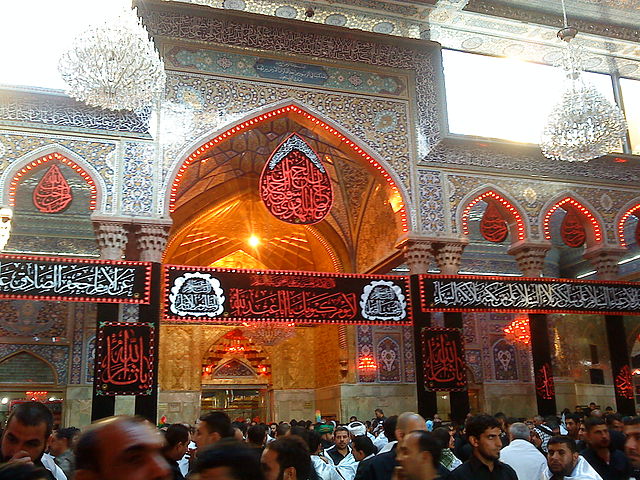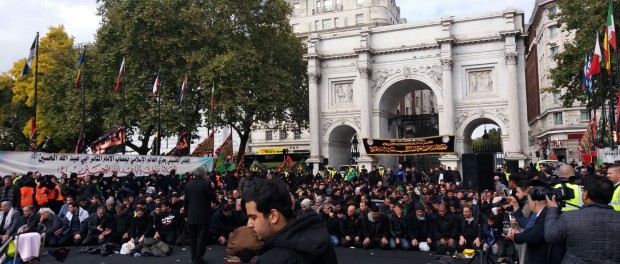
The day of Ashura, which falls on the 10th of Muharram, the first month of the Islamic lunar calendar, is important for Muslims globally. For Shia Muslims, however, the day holds special significance. It’s a day to commemorate the martyrdom of Husayn, a grandson of the Prophet Muhammad, who, alongside his male family members and companions, were murdered at Karbala in 681 AD.
Husayn bin Ali, the third Shi’i imam, had intended to travel from Medina to Kufa, where supporters had invited him to become their imam. The Umayyad governer, however, fearful of rebellion, halted Husayn’s caravan at Karbala. Troops ordered him to pledge fealty to Yazid, the second Umayyad caliph. The Umayyads were a dynasty of caliphs who ruled the Muslim empire between 661 and 750 AD. This group had descended from the Quraysh, who stood in opposition to Muhammad in Mecca. But Husayn did not recognise Yazid’s authority. And not without good reason. As Yazid’s appointment to Caliph was a direct result of his father’s broken promise. He turned his back on an earlier vow to allow Husayn to become caliph following the death of Husayn’s father Ali ibn Abi Talib (d. 661 AD). Ali was cousin and son-in-law to the Prophet Muhammad. Historically, Shia Muslims were a political faction known as the ‘party of Ali‘. It was their contention that a blood relative of the Prophet Muhammad should succeed him as leader of Muslims. As the first imam, Shia Muslims revere him as the inheritor to the Prophet’s legacy. In the Sunni tradition, Ali as the last of the Rightly Guided Caliphs. His desire to become caliphate came at the time of the Great Schism. His efforts to reunite divisions ended following his assassination on January 27, 661 AD.
On October 7, 680, Umayyad troops blocked their access to water. On the tenth day, Ashura, Umayyad forces murdered 72 men in Husayn’s company. This included Husayn’s six-month-old son, and a man aged 72. Husayn himself was later executed. The woman and children became prisoners and taken to Yazid’s palace in Damascus, which, at the time, served as capital of the Umayyad caliphate. Husayn’s sister Zaynab then confronted and shamed Yazid. This speech became its own legend. And Zaynab became forever known as the messenger of ‘Ashura‘.
In retaliation to this martyrdom, Shia communities in Kufan sought justice. After mourning at Husayn’s tomb in Karbala, they marched towards the capital of the Umayyad caliphate. Troops engaged them near the Syrian border and left few survivors. Soon a domed museulm was built over Husayn’s grave and a mosque was constructed on site. This sense of retribution has carried over in some Shia political thought for centuries. But it soon evolved into a pledge that could only be fulfilled in end times.
Husayn’s martyrdom retains strong symbolism in Islamic history. His shrine has become a vital place for Shia religious thought. Successive Shia rulers, including the 17th Century Safavids helped expand the shrine. Many now consider a pilgrimage to this shrine second only to pilgrimage to Mecca. This shrine has also served a cornerstone of Shia political thought and activism.
For Ithna Asharis, known broadly as the Twelvers, and Imamis, the largest subdivision in Shii Islam, the martyrdom holds special significance. Imamis contend that Husayn knew his destiny would result in martyrdom. He accepted this news in the belief that it would aid his supporters on the Day of Judgement. So they maintain that Husayn was the Prince of Martyrs. In other schools of Shia thought, however, this idea is absent or understated.
Ceremonies begin on the 10th and end on the 12th day. Cultural variations aside, some black-clad pilgrims beat their chests, self-flaggellate and chant “O Husayn!”
Others strew their faces with dust or mud as a sign of mourning. Some stage passion plays and re-enact key events which led up to the martyrdom of Husayn and his companions.

But this bloodletting is not without controversy. Some Shia clerics encourage blood donations instead. In 2009, over a thousand Shia in Afghanistan donated blood. In 2006, the Islamic Unity Society launched the National Imam Hussain Blood Donation campaign across Britain, which encourages Muslims to donate blood.
Yet, some media outlets place heavy emphasis on self-flagellation. A recent MailOnline headline had read: “Afghanistan baby gets head sliced open as part of Islamic self-flagellation ceremony”. Another balanced headline read: “‘Is that me cutting myself mum?’ A blood-stained Shiite boy clutching a huge knife joins his young friends in a bloody Muslim ceremony marking the sacrifice of the Prophet’s grandson”.
In 2015, Richard Dawkins, famed atheist and biologist, caused controversy after tweeting an image of an Ashura passion play outside of its context.
Nor would it be fair to characterise self-flagellation as a Shia-only tradition. While the Vatican does not approve of self-flaggelation, some Catholics in the Philippines continue this tradition in the run-up to Easter. Some cut their backs, then march barefooted for hours and repeatedly strike their backs with bamboo whips. A minority allow themselves to be crucificed for short periods of time. This controversial act of penance has been criticised by bishops in the Philippines. So not all Shia Muslims self-flaggelate. Nor do all Catholics. Yet the flagellation of the former, often fails to generate such bombastic headlines.
Nor do Shia communities escape sectarian violence. An attack on a Shia shrine in the Afghan capital of Kabul left at least 14 dead. Terror groups like ISIS consider Shia Muslims heretics. Yet this sense of self-sacrifice inspires some Shia in Iraq to criticise government corruption or join the fight against ISIS.
